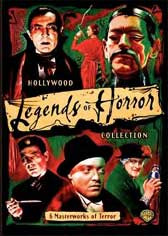 HOLLYWOOD
LEGENDS OF HORROR COLLECTION (1932-1939)
HOLLYWOOD
LEGENDS OF HORROR COLLECTION (1932-1939)Directors: Tod Browning, Charles Brabin, Karl Freund, Michael Curtiz, Vincent Sherman
Warner Home Video
 HOLLYWOOD
LEGENDS OF HORROR COLLECTION (1932-1939)
HOLLYWOOD
LEGENDS OF HORROR COLLECTION (1932-1939)This year’s Halloween present from the folks at Warner Home Video, the “Hollywood Legends of Horror” collection is a must-have box set containing golden age gems from the vaults of Metro-Goldwyn-Mayer and First National Pictures (who were controlled by Warner Bros.). Like’s last year’s “Val Lewton Collection,” the films here – MARK OF THE VAMPIRE/MASK OF FU MANCHU, MAD LOVE/THE DEVIL-DOLL and DR. X/THE RETURN OF DR. X – are double featured with box art (this time in slim slip cases) that show off the original theatrical posters. Starring such notables as Bela Lugosi, Boris Karloff, Lionel Atwill, Lionel Barrymore, Fay Wray and Humphrey Bogart (yes, Humphrey Bogart), here’s the set in a nutshell:
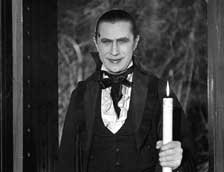
MARK OF THE VAMPIRE (1935) is director Tod Browning’s stylish remake of his own LONDON AFTER MIDNIGHT, which was shot in 1927 with Lon Chaney (who tackled two roles). In a Prague village, it is believed that the death of Sir Karell Borotyn (Holmes Herbert) was caused by the vampiric Count Mora (Bela Lugosi). In order to protect Borotyn's daughter Irena (Elizabeth Allan), vampire expert Professor Zelen (Lionel Barrymore) is brought in to take control and unravel the murder mystery with the help of Inspector Neumann (Lionel Atwill). Browning’s return to DRACULA territory has caused a lot of debate and disappointment among film buffs because of its cheat ending, but it does have merit. As Count Mora, Lugosi (in what is virtually a non-speaking role) repeats his Dracula persona with remarkably ghoulish flair, and he is often seen stalking the cobweb-incrusted castle (full of real bats and other creepy crawlers) with his undead daughter Luna, played by Carroll Borland. Although she only did a handful of film appearances, Borland became a huge cult figure because of her performance here, and she no doubt inspired the look of “Morticia Addams” and other vamps throughout cinematic history.
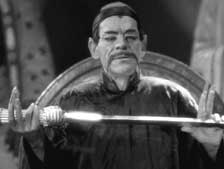 1932’s
THE MASK OF FU MANCHU (directed by Charles Brabin), is horror icon Boris Karloff’s
first and only performance as Sax Rohmer’s famous literary Asian super
villain. An expedition from the British Museum is mounted, setting out to find
the tomb of the ages-old warlord Genghis Khan and retrieve his legendary sword
and mask before they get in the hands of the powerful but evil Dr. Fu Manchu,
bent on conquering the white race! A wonderfully juicy performance by Karloff
and some extravagant, exotic sets highlight this pre-code horror entry, which
also contains a surprising amount of sadism and violence for its time. Lewis
Stone is Fu’s arch nemesis Nayland Smith, Myrna Loy is Fu’s sexy
daughter (though he calls her ugly during a public introduction), Charles Starrett
is the hero and Karen Morley is a rather harebrained heroine. THE MASK OF FU
MANCHU later ran into censorship problems and had a number of scenes –
which included racial slurs deemed offensive – trimmed, but this DVD restores
the film to its fully uncut glory.
1932’s
THE MASK OF FU MANCHU (directed by Charles Brabin), is horror icon Boris Karloff’s
first and only performance as Sax Rohmer’s famous literary Asian super
villain. An expedition from the British Museum is mounted, setting out to find
the tomb of the ages-old warlord Genghis Khan and retrieve his legendary sword
and mask before they get in the hands of the powerful but evil Dr. Fu Manchu,
bent on conquering the white race! A wonderfully juicy performance by Karloff
and some extravagant, exotic sets highlight this pre-code horror entry, which
also contains a surprising amount of sadism and violence for its time. Lewis
Stone is Fu’s arch nemesis Nayland Smith, Myrna Loy is Fu’s sexy
daughter (though he calls her ugly during a public introduction), Charles Starrett
is the hero and Karen Morley is a rather harebrained heroine. THE MASK OF FU
MANCHU later ran into censorship problems and had a number of scenes –
which included racial slurs deemed offensive – trimmed, but this DVD restores
the film to its fully uncut glory.
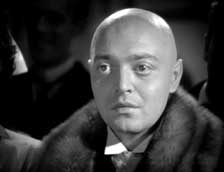
Directed by Karl Freund (THE MUMMY), MAD LOVE (1935) is one of the true classics of the 1930s and gives Peter Lorre (in his first American movie) one of his best performances of the decade. The first sound screen adaptation of the novel The Hands of Orlac, MAD LOVE had Lorre as brilliant surgeon Gogol, obsessed and in love with the beautiful Grand Guignol actress Yvonne Orlac (Francis Drake). When Yvonne’s husband, the concert pianist Stephen Orlac (Colin Clive, who’s billed in the accompanying trailer with “Doctor Frankenstein” under his credit) has his hands damaged in a train crash, she seeks Gogol’s help. Gogol grafts the hands of an executed knife-tossing killer onto Stephen, and the outcome results in murder, deception, and doomed love. The shaven-headed Lorre is properly creepy and sinister, growing more intensely fiendish and mad as his advances towards Yvonne are out rightly and understandably rejected. One of the best scenes has a whacked out Gogol in the guise of a murderer with a reattached head and metallic hands, trying to convince poor Orlac (a good job by Clive) that he’s a killer. The film also stars former Three Stooges leader Ted Healy as a wisecracking American reporter, Sara Haden, Edward Brophy and Keye Luke as Gogol’s assistant.
 Based
on Abraham Merritt’s novel Burn, Witch, Burn, THE DEVIL-DOLL
(1936) is one of the last films directed by Tod Browning. An entertaining blend
of melodrama and fantasy presented as a morality tale, the film stars Lionel
Barrymore as Paul Lavond, a double-crossed French banker who escapes from Devil’s
Island to enact revenge on a trio of ex partners. Lavond has hooked up with
a weird scientist who has devised a way to shrink people to doll size and control
them at will. When the scientist dies, his odd assistant Malita (Rafaela Ottiano)
follows Lavond to Paris, where he dons granny drag to hide his true identity
and sets up a doll shop. Using the astounding 12-inch human dolls, he is able
to infiltrate the homes of the three “swine” who framed him. Although
some of the effects are very awkwardly executed, the scenes of large setpieces
juxtaposed against actors playing miniature living dolls are still impressive,
and Barrymore is really terrific, with his old lady act being convincing enough
not only to thwart the police but also appease an intelligent audience. THE
DEVIL-DOLL also stars a very young Maureen O'Sullivan as Lavond’s daughter,
Frank Lawton, Robert Greig and Lucy Beaumont.
Based
on Abraham Merritt’s novel Burn, Witch, Burn, THE DEVIL-DOLL
(1936) is one of the last films directed by Tod Browning. An entertaining blend
of melodrama and fantasy presented as a morality tale, the film stars Lionel
Barrymore as Paul Lavond, a double-crossed French banker who escapes from Devil’s
Island to enact revenge on a trio of ex partners. Lavond has hooked up with
a weird scientist who has devised a way to shrink people to doll size and control
them at will. When the scientist dies, his odd assistant Malita (Rafaela Ottiano)
follows Lavond to Paris, where he dons granny drag to hide his true identity
and sets up a doll shop. Using the astounding 12-inch human dolls, he is able
to infiltrate the homes of the three “swine” who framed him. Although
some of the effects are very awkwardly executed, the scenes of large setpieces
juxtaposed against actors playing miniature living dolls are still impressive,
and Barrymore is really terrific, with his old lady act being convincing enough
not only to thwart the police but also appease an intelligent audience. THE
DEVIL-DOLL also stars a very young Maureen O'Sullivan as Lavond’s daughter,
Frank Lawton, Robert Greig and Lucy Beaumont.
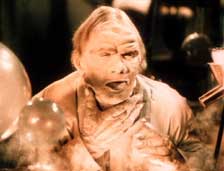
Shot in a 2-strip Technicolor process (a black and white version was also lensed simultaneously, and shown in some territories), DOCTOR X tells of an unidentified murderer, wanted for killing a number of people with strangulation and cannibalistic methods. It is believed that the guilty party resides at the New York academy of Dr. Xavier (Lionel Atwill), so an investigation is mounted with the help of Police Commissioner Stevens (Robert Warwick) and a nosy reporter (Lee Tracy). When the killer later reveals himself, he emerges as a hideous monster who has been experimenting with synthetic flesh. Fay Wray (who returned the next year with director Michael Curtis and Atwill for another Technicolor effort, MYSTERY IN THE WAX MUSEUM) looks breathtaking, and was one of the finest scream queens of the 1930s, even if it was only for a very brief period.
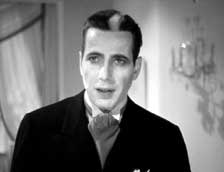 The
only relation that 1939’s THE RETURN OF DOCTOR X has with DOCTOR X is
the character name of “Dr. Xavier.” Here, yet another newspaper
reporter (Wayne Morris) discovers an actress dead in her apartment, only to
learn of her reemergence after writing a front-page story on her demise. Fired
from his job, he teams up with a friendly young doctor (Dennis Morgan) who finds
out that his elder colleague Dr. Francis (John Litel) has been up to no good.
Dr. Francis has dug up and revived the child-murdering, once executed Dr. Xavier
(Humphrey Bogart) who is now posing as “Dr. Quesne” and further
implementing his bizarre experiments. With a white streak through his hair and
pasty clown-face makeup, Bogey comes off as extremely uncomfortable in this
suspense yarn with supernatural overtones, which often resembles a Monogram
quickie (not that there’s anything wrong with that). To make Bogey (in
his only so-called horror film role) feel more at home, there’s a shootout
at the climax. Rosemary Lane is the underplayed heroine and Bowery Boy Huntz
Hall can be seen as a sharp-tongued copy boy.
The
only relation that 1939’s THE RETURN OF DOCTOR X has with DOCTOR X is
the character name of “Dr. Xavier.” Here, yet another newspaper
reporter (Wayne Morris) discovers an actress dead in her apartment, only to
learn of her reemergence after writing a front-page story on her demise. Fired
from his job, he teams up with a friendly young doctor (Dennis Morgan) who finds
out that his elder colleague Dr. Francis (John Litel) has been up to no good.
Dr. Francis has dug up and revived the child-murdering, once executed Dr. Xavier
(Humphrey Bogart) who is now posing as “Dr. Quesne” and further
implementing his bizarre experiments. With a white streak through his hair and
pasty clown-face makeup, Bogey comes off as extremely uncomfortable in this
suspense yarn with supernatural overtones, which often resembles a Monogram
quickie (not that there’s anything wrong with that). To make Bogey (in
his only so-called horror film role) feel more at home, there’s a shootout
at the climax. Rosemary Lane is the underplayed heroine and Bowery Boy Huntz
Hall can be seen as a sharp-tongued copy boy.
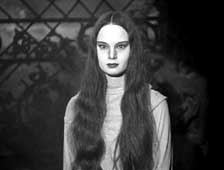
All titles are presented in their appropriate full screen aspect ratios, and aside from varying levels of occasional source print damage, the black and white images are solid with excellent detail. Out of the black and white titles, MARK OF THE VAMPIRE suffers the most apparent print damage, while THE RETURN OF DR. X is the most sparkling of the bunch. The Technicolor on DOCTOR X is as good as can be expected, while the print source (supplied by the film archives of UCLA) has a number of abrasions and a few splices. The mono audio on all titles is sufficient enough, with only minor hiss and crackling on occasion. Each title is presented with optional English, French and Spanish subtitles.
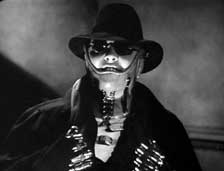 The
films on this set have diverse back stories such as footage removed before release,
initial casting choices and so forth, so it’s great to have commentaries
on all (with the exception of THE DEVIL-DOLL). All five commentaries are fact-filled
and entertaining at the same time, never running out of steam. Kim Newman and
Steve Jones (who came in from England to record this in LA) have fun with MARK
OF THE VAMPIRE, while Greg Mank ads his expertise to THE MASK OF FU MANCHU.
Steve Haberman is aboard to share his thoughts on MAD LOVE, and on DOCTOR X
is Scott MacQueen (doing impersonations of some of the people he discusses)
who conveys an inviting storytelling style not unlike humorist Jean Shepherd.
Haberman is back for THE RETURN OF DOCTOR X, which is extra special since it
also features the film’s 99-year-old director Vincent Sherman, who passed
away this year a month short of his 100th birthday. Sherman was still very sharp
as he discusses his career in general, his sole “horror” picture
and his relationship with Bogart. All titles (except for THE MASK OF FU MANCHU)
include their original trailers. MARK OF THE VAMPIRE is a hoot since it has
Lugosi in character spurting more dialogue than he does in the actual film,
and Lorre can be seen as himself in the trailer for MAD LOVE, addressing a female
phone interviewer from the seat of his armchair. (George
R. Reis)
The
films on this set have diverse back stories such as footage removed before release,
initial casting choices and so forth, so it’s great to have commentaries
on all (with the exception of THE DEVIL-DOLL). All five commentaries are fact-filled
and entertaining at the same time, never running out of steam. Kim Newman and
Steve Jones (who came in from England to record this in LA) have fun with MARK
OF THE VAMPIRE, while Greg Mank ads his expertise to THE MASK OF FU MANCHU.
Steve Haberman is aboard to share his thoughts on MAD LOVE, and on DOCTOR X
is Scott MacQueen (doing impersonations of some of the people he discusses)
who conveys an inviting storytelling style not unlike humorist Jean Shepherd.
Haberman is back for THE RETURN OF DOCTOR X, which is extra special since it
also features the film’s 99-year-old director Vincent Sherman, who passed
away this year a month short of his 100th birthday. Sherman was still very sharp
as he discusses his career in general, his sole “horror” picture
and his relationship with Bogart. All titles (except for THE MASK OF FU MANCHU)
include their original trailers. MARK OF THE VAMPIRE is a hoot since it has
Lugosi in character spurting more dialogue than he does in the actual film,
and Lorre can be seen as himself in the trailer for MAD LOVE, addressing a female
phone interviewer from the seat of his armchair. (George
R. Reis)